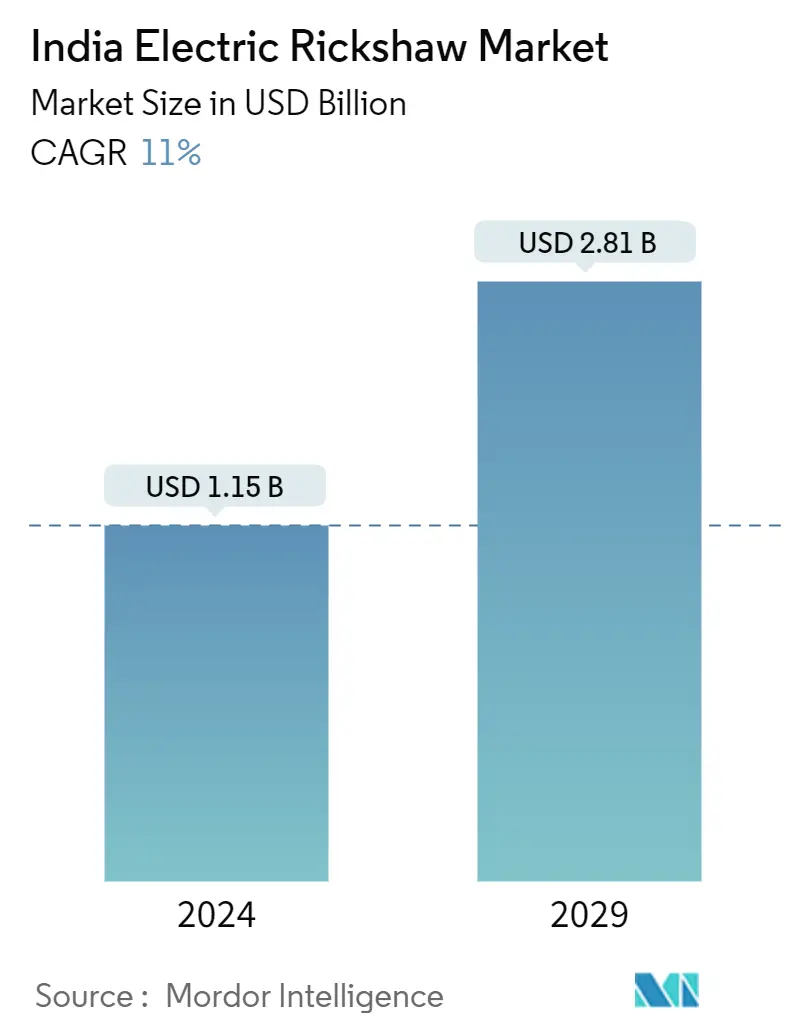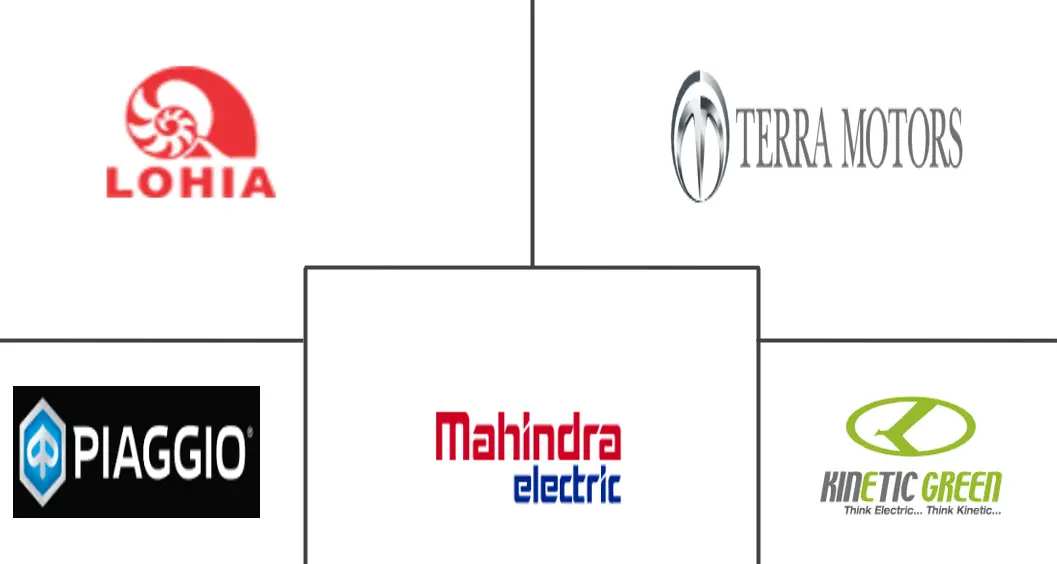Market Size of India Electric Rickshaw Industry

| Study Period | 2019 - 2029 |
| Base Year For Estimation | 2023 |
| Market Size (2024) | USD 1.15 Billion |
| Market Size (2029) | USD 2.81 Billion |
| CAGR (2024 - 2029) | 11.00 % |
| Market Concentration | Medium |
Major Players
*Disclaimer: Major Players sorted in no particular order |
India Electric Rickshaw Market Analysis
The India Electric Rickshaw Market size is estimated at USD 1.15 billion in 2024, and is expected to reach USD 2.81 billion by 2029, growing at a CAGR of 11% during the forecast period (2024-2029).
The electric rickshaw market in India holds significant importance due to its contribution to the country's transportation sector and its role in promoting eco-friendly alternatives. The market has witnessed substantial growth in recent years, driven by factors such as increasing environmental concerns, government initiatives, and technological advancements.
Several driving factors have contributed to India's increasing number of electric rickshaws. Firstly, the Indian government has launched numerous initiatives to encourage the adoption of electric vehicles (EVs) to combat air pollution and reduce carbon emissions, which has led to the provision of subsidies, tax benefits, and infrastructure development for EV charging stations. Additionally, electric rickshaws offer cost-effective solutions for operators and passengers, as they are less expensive to maintain and operate than traditional fuel-powered vehicles. E-rickshaws are user-friendly, easy to maneuver in congested urban areas, and require minimal training for drivers.
One of the primary challenges is the lack of standardization regarding quality, safety, and performance, leading to the proliferation of low-quality e-rickshaws, which may compromise safety and affect the overall market perception. However, this also presents an opportunity for manufacturers to focus on improving the quality and reliability of their products. Another challenge is the limited charging infrastructure, which can hinder the widespread adoption of electric rickshaws. To overcome this challenge, the government and private players can collaborate to establish more charging stations across the country.
Uttar Pradesh is expected to be the largest e-rickshaw market in India, followed by Delhi, during the forecast period due to the growing demand for these rickshaws in tier-1 cities, tier-2 cities, and the rural-urban periphery. There are around 4.53 lakh e-rickshaws in Uttar Pradesh, 1.41 lakh e-rickshaws alone in Delhi, and a total of around 9 lakh e-rickshaws in India. In addition, other states, such as Bihar, West Bengal, and Assam, are witnessing significant demand for these rickshaws.
As the market matures, it is expected to witness further growth in terms of adoption, technological advancements, and infrastructure development. Manufacturers should focus on innovation, safety, and quality to capitalize on this opportunity. The Indian government can also promote the market by increasing subsidies, providing tax incentives, and investing in charging infrastructure. In the long run, the electric rickshaw market in India has the potential to become a key player in the country's efforts to transition toward a cleaner and more sustainable transportation system.
India Electric Rickshaw Industry Segmentation
E-rickshaw is an electric-powered, three-wheeled vehicle primarily used to transport passengers and goods commercially. E-rickshaw is also known as an electric tuk-tuk and toto. It utilizes a battery and an electrified powertrain to propel the vehicle. The Indian electric rickshaw market is segmented by end user, battery type, battery capacity, and state.
By end user, the market is segmented into passenger carriers and goods carriers. By battery type, the market is segmented into lithium-ion, lead acid, and other battery types. By battery capacity, the market is segmented into up to 3 KWh and more than 3 KWh. By state, the market is segmented into Maharashtra, Uttar Pradesh, Tamil Nadu, Rajasthan, Punjab, Karnataka, Delhi, Telangana, and Rest of India. For each segment, market size and forecast have been calculated based on value (USD).
| By End User | |
| Passenger Carriers | |
| Goods Carriers |
| By Battery Type | |
| Lithium-ion Battery | |
| Lead Acid Battery | |
| Other Battery Types |
| By Battery Capacity | |
| Up to 3 KWh | |
| More than 3 KWh |
| By States | |
| Maharashtra | |
| Uttar Pradesh | |
| Tamil Nadu | |
| Rajasthan | |
| Punjab | |
| Karnataka | |
| Delhi | |
| Telangana | |
| Rest of India |
India Electric Rickshaw Market Size Summary
The electric rickshaw market in India is poised for significant growth, driven by increasing environmental awareness, government support, and technological advancements. The market is gaining traction as a sustainable alternative to traditional fuel-powered vehicles, with electric rickshaws offering cost-effective solutions for both operators and passengers. The Indian government's initiatives, such as subsidies, tax benefits, and infrastructure development for EV charging stations, are pivotal in promoting the adoption of electric vehicles. Despite challenges like the lack of standardization and limited charging infrastructure, the market presents opportunities for manufacturers to enhance product quality and reliability. The passenger carrier segment is expected to experience rapid growth, fueled by the rising demand for economical and eco-friendly public transportation, particularly in urban areas.
Major cities like Delhi and Uttar Pradesh are leading the charge in the electric rickshaw market, with significant sales and government incentives driving adoption. The market is characterized by a large number of small, unorganized local players, alongside established companies like Lohia Auto Industries and Kinetic Green Energy. The introduction of new models and expansion plans by manufacturers, such as Mahindra and Udaan, are set to further boost the market. Government policies and initiatives, including the Faster Adoption and Manufacturing of (Hybrid) and Electric Vehicles in India (FAME) scheme, are crucial in supporting the market's growth. As the market matures, the focus on innovation, safety, and quality will be essential for manufacturers to meet the evolving needs of Indian consumers and contribute to a cleaner, more sustainable transportation system.
India Electric Rickshaw Market Size - Table of Contents
-
1. MARKET DYNAMICS
-
1.1 Market Drivers
-
1.1.1 Government Initiatives and Subsidies Help Boost Electric Rikshaw Sales in India
-
-
1.2 Market Restraints
-
1.2.1 Limited Charging Infrastructure and Range Anxiety May Hamper the Growth of Electric Rikshaw Sales in India
-
-
1.3 Industry Attractiveness - Porter's Five Forces Analysis
-
1.3.1 Bargaining Power of Buyers/Consumers
-
1.3.2 Bargaining Power of Suppliers
-
1.3.3 Threat of New Entrants
-
1.3.4 Threat of Substitute Products
-
1.3.5 Intensity of Competitive Rivalry
-
-
-
2. MARKET SEGMENTATION (Market Size by Value - USD Million)
-
2.1 By End User
-
2.1.1 Passenger Carriers
-
2.1.2 Goods Carriers
-
-
2.2 By Battery Type
-
2.2.1 Lithium-ion Battery
-
2.2.2 Lead Acid Battery
-
2.2.3 Other Battery Types
-
-
2.3 By Battery Capacity
-
2.3.1 Up to 3 KWh
-
2.3.2 More than 3 KWh
-
-
2.4 By States
-
2.4.1 Maharashtra
-
2.4.2 Uttar Pradesh
-
2.4.3 Tamil Nadu
-
2.4.4 Rajasthan
-
2.4.5 Punjab
-
2.4.6 Karnataka
-
2.4.7 Delhi
-
2.4.8 Telangana
-
2.4.9 Rest of India
-
-
India Electric Rickshaw Market Size FAQs
How big is the India Electric Rickshaw Market?
The India Electric Rickshaw Market size is expected to reach USD 1.15 billion in 2024 and grow at a CAGR of 11% to reach USD 2.81 billion by 2029.
What is the current India Electric Rickshaw Market size?
In 2024, the India Electric Rickshaw Market size is expected to reach USD 1.15 billion.

